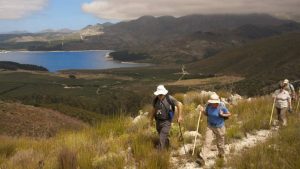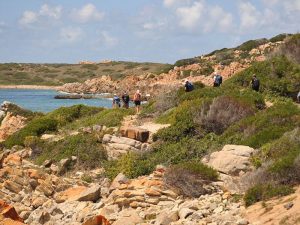South Africa is known for its ever-varying landscape, and there’s no better way to experience the Rainbow Nation’s many faces than to get out and explore the great outdoors. Trek across the country’s nine provinces you’ll find dusty semi-desert and cloud-topped mountains, crashing waves and trickling rivers, dense forests and craggy cliffs where it seems almost nothing can grow.
But if you’re anything like me, while you relish raw elemental nature by day, once the sun is replaced by stars you prefer a hot shower, a comfy mattress and flushing facilities for midnight nature calls. Welcome to slackpacking: a touring style that allows you to swap hiking boots for slippers in the evening, and tackle multi-day treks without giving up creature comforts. You carry only what you’ll need during a day’s trek, and at sundown you’ll find your baggage by your bed in a luxurious lodge or charming guest house.
If this sounds appealing to you, read on for details of seven of South Africa’s swankiest slackpacking trails.
Green Mountain Trail
Part mountainous hike and part gourmand adventure, the Green Mountain Trail takes in the best of the Elgin region. Just an hour’s drive from Cape Town, the four-day trail tackles hilly terrain, but little indulgences await at the top of every mountain path. The fairly long hiking days – distances covered range from 11km to 18km per day – are punctuated with treats like white-tableclothed picnics featuring artisanal bread, cheese and olives, or sneaky wine tastings to break up the hike. Each night, following a lavish dinner, you roll into bed in an elegant country house. Hearty breakfasts and impressive spreads for afternoon tea pretty much ensure that you’ll only manage to burn as many calories as you consume over the four days.
Dolphin Trail
Hugging the Eastern Cape coast, the Dolphin Trail is often considered the slackpacking hike par excellence. The trail covers just 17km over two days, giving plenty of time to stop along the way to snap photographs, snorkel or take a dip in cooling rock pools. The dramatic hike takes in the best that the Tsitsikamma region has to offer – Indiana Jones-like suspension bridges span the void between cliffs topped with dense patches of forest. Far below, the frothing ocean travels up rocky inlets, where occasional waterfalls tumble down the cliff side. The trail offers a more relaxing – and less in demand – alternative to the legendary Otter Trail, whose places are usually booked up almost a year in advance.
Oystercatcher Trail
For those who like a little history with their hiking, Mossel Bay’s Oystercatcher Trail offers plenty of interest alongside the usual scenic drawcards. The Garden Route hike follows the coast, dipping into coastal caves, including Pinnacle Point where important archaeological and anthropological clues have been unearthed. The trail comes with a range of options, from one-day walks for the hiker in a hurry, to three-day alternatives tailored to a variety of budgets. Spoil yourself with the Gold option where meals and drinks are all included and you’ll celebrate the end of the trail with a glass of bubbly in your beach house.
Chokka Trail
Named for one of the region’s most important industries (chokka is the local word for squid), this is another seaside hike, this time on the Eastern Cape’s Sunshine Coast. Beginning in Oyster Bay, the walk takes in 58km of coast – and some spectacularly tranquil inland sand dunes – over four days. Diversions abound, with pauses taken from the trail to cruise the canals of St Francis, peruse shipwrecks off the coast, visit a penguin rehabilitation project, join a tasting of the local chokka and get an inside look into the industry. Whale-watchers and bird-spotters will enjoy seasonal luck while lovers of luxury are catered for each evening as they check into a different waterfront guesthouse.
Perlemoen Trail
Although it’s just a few hours’ drive from Cape Town, this stretch of Overberg coast tends to be overlooked by visitors. The Perlemoen Trail – named for the perlemoen (abalone) that are found, and often poached, in the waters here – stretches from Die Dam in the east to Hermanus in the west. Sections of the trail can be tackled in anything from one to ten days, though the usual route covers around 48km over three days of walking. Tramp over long, empty beaches, past coastal fynbos and shipwrecks, beneath cliffs and into fascinating caves once inhabited by the indigenous Khoisan people. Nights are spent in a string of enchanting guest houses, with authentic local cuisine served each evening in a nearby restaurant or pub.
Wild Coast Walk
Back in the Eastern Cape, the Wild Coast has long been known for its hiking possibilities. This classic walk covers 85km of spectacular coastline over six days. Starting at Qora River, you traverse sand dunes and pass shipwrecks, wade across river mouths, or when the tide is high jump on a quick ferry to get you to the next sandy inlet. Break up all that walking with a quick dip in a tidal pool or with a morning cultural tour to a local Xhosa community. Each day’s hiking brings you to a new home in the form of one of the family-friendly lodges sitting in windswept Wild Coast towns, where fresh fish and a well-earned cold beer are the order of the day.
Wartrail Skywalk
Some 300km inland from the remarkable scenery of the Wild Coast, the Wartrail Skywalk serves to prove just how varied the landscape of the Eastern Cape is. Bordering the southern edge of Lesotho, this section of the Drakensberg is far less well-known – and less visited – than its counterpart to the north in KwaZulu-Natal. The four-day trail meanders through the verdant mountains. En route, hop over streams, look out for eagles soaring overhead and revel in the fact that you’re unlikely to meet any other hikers on this offbeat route. Each day in the mountains ends with a home-cooked meal in an authentic Drakensberg farmhouse.




